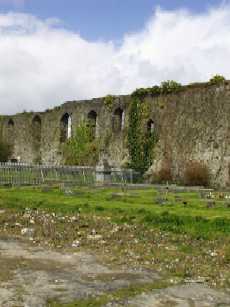|
In 1973, the Dominican Order were asked by the then Bishop, Henry Murphy
to form a new parish, which would be located between the Roxborough Road
and Glentworth Street. This new parish is known as St. Saviour's. According
to Lenihan, Donogh Cairbreagh O'Brien founded the Dominican friary in
1227. The original friary was situated in the grounds of the present day
Convent of Mercy in Convent St, which is off Barrack St. There were a
number of tombs in the original convent. Among the people buried at the
original site were Donogh O'Brien, the 6th Earl of Desmond, Bishops of
the dioceses of Killaloe, Kilfenora and Limerick and John O'Grady, Archbishop
of Cashel.
The original friary was situated near the city walls and as a result
was damaged a number of times during the many attacks on the city during
the 13th and 14th centuries. James FitzJohn, the 6th Earl of Desmond,
who was buried here in 1462, rebuilt the friary.

© Part of the wall of the original Dominican Convent church

© Part of the wall of the original Dominican Convent church
Before the dissolution of 1541 when King Henry VIII split
with the Papacy, the friary had acquired a large amount of wealth. Not
wanting to return to their former unbefitting concentration on wealth
instead of on a life of prayer and devotion, the house in Limerick returned
to a stricter observance of the Rule, and they became known as the Black
Friars Observant. The friary's properties were granted to James Fitzgerald,
the Earl of Desmond in 1544 with a yearly rent of 5s 2d sterling.
The friary owned the church site, a cemetery and land both
inside and outside the city walls. During Queen Mary's reign, James, the
Earl of Desmond returned the property to the Dominicans but Queen Mary
was entitled to use the friary's resources for her needs. It was later
passed onto the Earl of Thomond.
The Dominicans stayed in or around the city during the suppression.
In 1613, there were three Dominicans priests living in the community and,
by 1622, there were six Dominicans in the city. During the Confederate
war, the Dominicans repossessed their old friary of St. Saviour's and
a chapel was built in the grounds of St Saviour's friary. All that remains
of the original friary is the north wall of the church as most of the
building was destroyed in 1691.
Pope Innocent X granted a Papal university for Limerick
in 1644 for the Catholic Confederation. However, the political situation
changed again in England when Oliver Cromwell came to power in England
in 1649. The Roman Catholic faith was again under attack. During the siege
of Limerick in 1651, Cromwellian forces under General Ireton murdered
a number of Dominicans friars. Among those killed were Bishop Terence
Albert O'Brien (see church section) and Fr James Wolfe.
In the 1660s, during the reign of Charles II, the authorities
allowed a certain form of religious life to take place and the Dominicans
began to organise again into priory. The situation changed once more in
the latter years of the 17th century with the introduction of the Penal
Code in 1695 and an Act of Parliament in 1697, which legislated for the
banning of all Papists excerising any ecclesiastical practices.
The following year, the Dominicans, together with the others
religious orders in the city, were expelled. However, three members of
the orders stayed in the city. According to Myles Nolan, author of Dominicans
of Limerick 1227-1977, they were Fathers John Halpin, Francis O'Grady
and Denis O'Gallagher. Nolan states that the Dominicans began to live
as a community again around 1710. Judith Hill mentions that the Dominicans
were in Gaol Lane in 1730 when they built a chapel within a house that
they also used as their living quarters. This house was situated in Mary
Street.
The Dominicans erected a chapel on a site in Fish Lane in
1780 according to Ferrar's History of Limerick from 1787. However, Nolan
quotes from the private writings of Fr James Joseph Carberry OP (a member
of the Dominican Order in Limerick) dated to 1866, which state that the
church was opened in 1735 and measured 60 feet by 30 feet with wide galleries.
The east wall of the chapel in Fish Lane still remains and is made of
red brick and limestone. However, there is relatively little information
on this church. For a more complete history of the Dominican Order in
Limerick since 1227, you should consult The Dominicans in Limerick 1227-1977
by Myles Nolan, which was published to commemorate the 750th anniversary
of Dominicans arrival in Limerick.
  
|